[English] 日本語
 Yorodumi
Yorodumi- PDB-6a5o: RNA polymerase II elongation complex stalled at SHL(-6) of the nu... -
+ Open data
Open data
- Basic information
Basic information
| Entry | Database: PDB / ID: 6a5o | |||||||||||||||||||||
|---|---|---|---|---|---|---|---|---|---|---|---|---|---|---|---|---|---|---|---|---|---|---|
| Title | RNA polymerase II elongation complex stalled at SHL(-6) of the nucleosome | |||||||||||||||||||||
 Components Components |
| |||||||||||||||||||||
 Keywords Keywords | TRANSCRIPTION/RNA/DNA / nucleosome / chromatin / RNA polymerase / TRANSCRIPTION / TRANSCRIPTION-RNA-DNA complex | |||||||||||||||||||||
| Function / homology |  Function and homology information Function and homology informationnuclear DNA-directed RNA polymerase complex / regulation of septum digestion after cytokinesis / siRNA-mediated pericentric heterochromatin formation / negative regulation of chromosome condensation / Barr body / regulation of centromere complex assembly / pericentric heterochromatin formation / RPB4-RPB7 complex / inner kinetochore / muscle cell differentiation ...nuclear DNA-directed RNA polymerase complex / regulation of septum digestion after cytokinesis / siRNA-mediated pericentric heterochromatin formation / negative regulation of chromosome condensation / Barr body / regulation of centromere complex assembly / pericentric heterochromatin formation / RPB4-RPB7 complex / inner kinetochore / muscle cell differentiation / oocyte maturation / nuclear-transcribed mRNA catabolic process, deadenylation-dependent decay / termination of RNA polymerase II transcription / nucleus organization / termination of RNA polymerase III transcription / transcription initiation at RNA polymerase III promoter / RNA polymerase III activity / termination of RNA polymerase I transcription / transcription initiation at RNA polymerase I promoter / positive regulation of nuclear-transcribed mRNA poly(A) tail shortening / RNA polymerase II activity / spermatid development / negative regulation of tumor necrosis factor-mediated signaling pathway / subtelomeric heterochromatin formation / single fertilization / transcription elongation by RNA polymerase I / negative regulation of megakaryocyte differentiation / RNA polymerase II core promoter sequence-specific DNA binding / tRNA transcription by RNA polymerase III / RNA polymerase I complex / RNA polymerase I activity / RNA polymerase III complex / positive regulation of translational initiation / protein localization to CENP-A containing chromatin / RNA polymerase II, core complex / pericentric heterochromatin / Replacement of protamines by nucleosomes in the male pronucleus / CENP-A containing nucleosome / Packaging Of Telomere Ends / Recognition and association of DNA glycosylase with site containing an affected purine / Cleavage of the damaged purine / Deposition of new CENPA-containing nucleosomes at the centromere / nucleosomal DNA binding / Recognition and association of DNA glycosylase with site containing an affected pyrimidine / Cleavage of the damaged pyrimidine / translation initiation factor binding / Inhibition of DNA recombination at telomere / telomere organization / embryo implantation / Meiotic synapsis / RNA Polymerase I Promoter Opening / Assembly of the ORC complex at the origin of replication / SUMOylation of chromatin organization proteins / Regulation of endogenous retroelements by the Human Silencing Hub (HUSH) complex / DNA methylation / Condensation of Prophase Chromosomes / SIRT1 negatively regulates rRNA expression / Chromatin modifications during the maternal to zygotic transition (MZT) / ERCC6 (CSB) and EHMT2 (G9a) positively regulate rRNA expression / HCMV Late Events / innate immune response in mucosa / PRC2 methylates histones and DNA / Regulation of endogenous retroelements by KRAB-ZFP proteins / Defective pyroptosis / Regulation of endogenous retroelements by Piwi-interacting RNAs (piRNAs) / HDACs deacetylate histones / transcription initiation at RNA polymerase II promoter / Nonhomologous End-Joining (NHEJ) / RNA Polymerase I Promoter Escape / lipopolysaccharide binding / transcription elongation by RNA polymerase II / Transcriptional regulation by small RNAs / Formation of the beta-catenin:TCF transactivating complex / P-body / RUNX1 regulates genes involved in megakaryocyte differentiation and platelet function / NoRC negatively regulates rRNA expression / Activated PKN1 stimulates transcription of AR (androgen receptor) regulated genes KLK2 and KLK3 / G2/M DNA damage checkpoint / HDMs demethylate histones / B-WICH complex positively regulates rRNA expression / multicellular organism growth / DNA Damage/Telomere Stress Induced Senescence / heterochromatin formation / ribonucleoside binding / PKMTs methylate histone lysines / Metalloprotease DUBs / Meiotic recombination / Pre-NOTCH Transcription and Translation / RMTs methylate histone arginines / Activation of anterior HOX genes in hindbrain development during early embryogenesis / DNA-directed 5'-3' RNA polymerase activity / DNA-directed RNA polymerase / HCMV Early Events / Transcriptional regulation of granulopoiesis / osteoblast differentiation / male gonad development / structural constituent of chromatin / UCH proteinases / antimicrobial humoral immune response mediated by antimicrobial peptide / nucleosome Similarity search - Function | |||||||||||||||||||||
| Biological species |  Homo sapiens (human) Homo sapiens (human) Komagataella phaffii (fungus) Komagataella phaffii (fungus)synthetic construct (others) | |||||||||||||||||||||
| Method | ELECTRON MICROSCOPY / single particle reconstruction / cryo EM / Resolution: 9.9 Å | |||||||||||||||||||||
 Authors Authors | Kujirai, T. / Ehara, H. / Fujino, Y. / Shirouzu, M. / Sekine, S. / Kurumizaka, H. | |||||||||||||||||||||
| Funding support |  Japan, 6items Japan, 6items
| |||||||||||||||||||||
 Citation Citation |  Journal: Science / Year: 2018 Journal: Science / Year: 2018Title: Structural basis of the nucleosome transition during RNA polymerase II passage. Authors: Tomoya Kujirai / Haruhiko Ehara / Yuka Fujino / Mikako Shirouzu / Shun-Ichi Sekine / Hitoshi Kurumizaka /  Abstract: Genomic DNA forms chromatin, in which the nucleosome is the repeating unit. The mechanism by which RNA polymerase II (RNAPII) transcribes the nucleosomal DNA remains unclear. Here we report the cryo- ...Genomic DNA forms chromatin, in which the nucleosome is the repeating unit. The mechanism by which RNA polymerase II (RNAPII) transcribes the nucleosomal DNA remains unclear. Here we report the cryo-electron microscopy structures of RNAPII-nucleosome complexes in which RNAPII pauses at the superhelical locations SHL(-6), SHL(-5), SHL(-2), and SHL(-1) of the nucleosome. RNAPII pauses at the major histone-DNA contact sites, and the nucleosome interactions with the RNAPII subunits stabilize the pause. These structures reveal snapshots of nucleosomal transcription, in which RNAPII gradually tears DNA from the histone surface while preserving the histone octamer. The nucleosomes in the SHL(-1) complexes are bound to a "foreign" DNA segment, which might explain the histone transfer mechanism. These results provide the foundations for understanding chromatin transcription and epigenetic regulation. | |||||||||||||||||||||
| History |
|
- Structure visualization
Structure visualization
| Movie |
 Movie viewer Movie viewer |
|---|---|
| Structure viewer | Molecule:  Molmil Molmil Jmol/JSmol Jmol/JSmol |
- Downloads & links
Downloads & links
- Download
Download
| PDBx/mmCIF format |  6a5o.cif.gz 6a5o.cif.gz | 1 MB | Display |  PDBx/mmCIF format PDBx/mmCIF format |
|---|---|---|---|---|
| PDB format |  pdb6a5o.ent.gz pdb6a5o.ent.gz | 820.5 KB | Display |  PDB format PDB format |
| PDBx/mmJSON format |  6a5o.json.gz 6a5o.json.gz | Tree view |  PDBx/mmJSON format PDBx/mmJSON format | |
| Others |  Other downloads Other downloads |
-Validation report
| Summary document |  6a5o_validation.pdf.gz 6a5o_validation.pdf.gz | 1 MB | Display |  wwPDB validaton report wwPDB validaton report |
|---|---|---|---|---|
| Full document |  6a5o_full_validation.pdf.gz 6a5o_full_validation.pdf.gz | 1.1 MB | Display | |
| Data in XML |  6a5o_validation.xml.gz 6a5o_validation.xml.gz | 118 KB | Display | |
| Data in CIF |  6a5o_validation.cif.gz 6a5o_validation.cif.gz | 194 KB | Display | |
| Arichive directory |  https://data.pdbj.org/pub/pdb/validation_reports/a5/6a5o https://data.pdbj.org/pub/pdb/validation_reports/a5/6a5o ftp://data.pdbj.org/pub/pdb/validation_reports/a5/6a5o ftp://data.pdbj.org/pub/pdb/validation_reports/a5/6a5o | HTTPS FTP |
-Related structure data
| Related structure data |  6981MC  6980C  6982C  6983C  6984C  6985C  6986C  6a5lC  6a5pC  6a5rC  6a5tC  6a5uC  6inqC M: map data used to model this data C: citing same article ( |
|---|---|
| Similar structure data |
- Links
Links
- Assembly
Assembly
| Deposited unit | 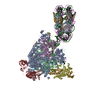
|
|---|---|
| 1 |
|
- Components
Components
-DNA-directed RNA polymerase ... , 3 types, 3 molecules ABI
| #1: Protein | Mass: 194107.422 Da / Num. of mol.: 1 / Source method: isolated from a natural source Source: (natural)  Komagataella phaffii (strain GS115 / ATCC 20864) (fungus) Komagataella phaffii (strain GS115 / ATCC 20864) (fungus)Strain: GS115 / ATCC 20864 / References: UniProt: C4R4Y0, DNA-directed RNA polymerase |
|---|---|
| #2: Protein | Mass: 139746.094 Da / Num. of mol.: 1 / Source method: isolated from a natural source Source: (natural)  Komagataella phaffii (strain GS115 / ATCC 20864) (fungus) Komagataella phaffii (strain GS115 / ATCC 20864) (fungus)Strain: GS115 / ATCC 20864 / References: UniProt: C4QZQ7, DNA-directed RNA polymerase |
| #9: Protein | Mass: 13612.320 Da / Num. of mol.: 1 / Source method: isolated from a natural source Source: (natural)  Komagataella phaffii (strain GS115 / ATCC 20864) (fungus) Komagataella phaffii (strain GS115 / ATCC 20864) (fungus)Strain: GS115 / ATCC 20864 / References: UniProt: F2QPE6 |
-RNA polymerase II ... , 4 types, 4 molecules CDGK
| #3: Protein | Mass: 34216.293 Da / Num. of mol.: 1 / Source method: isolated from a natural source Source: (natural)  Komagataella phaffii (strain GS115 / ATCC 20864) (fungus) Komagataella phaffii (strain GS115 / ATCC 20864) (fungus)Strain: GS115 / ATCC 20864 / References: UniProt: C4R7L2 |
|---|---|
| #4: Protein | Mass: 20622.980 Da / Num. of mol.: 1 / Source method: isolated from a natural source Source: (natural)  Komagataella phaffii (strain GS115 / ATCC 20864) (fungus) Komagataella phaffii (strain GS115 / ATCC 20864) (fungus)Strain: GS115 / ATCC 20864 / References: UniProt: C4R2U9 |
| #7: Protein | Mass: 18802.625 Da / Num. of mol.: 1 / Source method: isolated from a natural source Source: (natural)  Komagataella phaffii (strain GS115 / ATCC 20864) (fungus) Komagataella phaffii (strain GS115 / ATCC 20864) (fungus)Strain: GS115 / ATCC 20864 / References: UniProt: C4R9A1 |
| #11: Protein | Mass: 13832.896 Da / Num. of mol.: 1 / Source method: isolated from a natural source Source: (natural)  Komagataella phaffii (strain GS115 / ATCC 20864) (fungus) Komagataella phaffii (strain GS115 / ATCC 20864) (fungus)Strain: GS115 / ATCC 20864 / References: UniProt: C4R3Z5 |
-RNA polymerase subunit ... , 4 types, 4 molecules EFJL
| #5: Protein | Mass: 24962.680 Da / Num. of mol.: 1 / Source method: isolated from a natural source Source: (natural)  Komagataella phaffii (strain GS115 / ATCC 20864) (fungus) Komagataella phaffii (strain GS115 / ATCC 20864) (fungus)Strain: GS115 / ATCC 20864 / References: UniProt: C4R3P8 |
|---|---|
| #6: Protein | Mass: 17803.588 Da / Num. of mol.: 1 / Source method: isolated from a natural source Source: (natural)  Komagataella phaffii (strain GS115 / ATCC 20864) (fungus) Komagataella phaffii (strain GS115 / ATCC 20864) (fungus)Strain: GS115 / ATCC 20864 / References: UniProt: C4R1V1 |
| #10: Protein | Mass: 8554.064 Da / Num. of mol.: 1 / Source method: isolated from a natural source Source: (natural)  Komagataella phaffii (strain GS115 / ATCC 20864) (fungus) Komagataella phaffii (strain GS115 / ATCC 20864) (fungus)Strain: GS115 / ATCC 20864 / References: UniProt: C4R009 |
| #12: Protein | Mass: 7862.048 Da / Num. of mol.: 1 / Source method: isolated from a natural source Source: (natural)  Komagataella phaffii (strain GS115 / ATCC 20864) (fungus) Komagataella phaffii (strain GS115 / ATCC 20864) (fungus)Strain: GS115 / ATCC 20864 / References: UniProt: F2QMI1 |
-Protein , 5 types, 9 molecules Haebfcgdh
| #8: Protein | Mass: 16249.220 Da / Num. of mol.: 1 / Source method: isolated from a natural source Source: (natural)  Komagataella phaffii (strain GS115 / ATCC 20864) (fungus) Komagataella phaffii (strain GS115 / ATCC 20864) (fungus)Strain: GS115 / ATCC 20864 / References: UniProt: C4R273 | ||||||
|---|---|---|---|---|---|---|---|
| #16: Protein | Mass: 15643.262 Da / Num. of mol.: 2 Source method: isolated from a genetically manipulated source Source: (gene. exp.)  Homo sapiens (human) / Gene: H3F3A, H3.3A, H3F3, PP781, H3F3B, H3.3B / Production host: Homo sapiens (human) / Gene: H3F3A, H3.3A, H3F3, PP781, H3F3B, H3.3B / Production host:  #17: Protein | Mass: 11676.703 Da / Num. of mol.: 2 Source method: isolated from a genetically manipulated source Source: (gene. exp.)  Homo sapiens (human) Homo sapiens (human)Gene: HIST1H4A, H4/A, H4FA, HIST1H4B, H4/I, H4FI, HIST1H4C, H4/G, H4FG, HIST1H4D, H4/B, H4FB, HIST1H4E, H4/J, H4FJ, HIST1H4F, H4/C, H4FC, HIST1H4H, H4/H, H4FH, HIST1H4I, H4/M, H4FM, HIST1H4J, H4/E, ...Gene: HIST1H4A, H4/A, H4FA, HIST1H4B, H4/I, H4FI, HIST1H4C, H4/G, H4FG, HIST1H4D, H4/B, H4FB, HIST1H4E, H4/J, H4FJ, HIST1H4F, H4/C, H4FC, HIST1H4H, H4/H, H4FH, HIST1H4I, H4/M, H4FM, HIST1H4J, H4/E, H4FE, HIST1H4K, H4/D, H4FD, HIST1H4L, H4/K, H4FK, HIST2H4A, H4/N, H4F2, H4FN, HIST2H4, HIST2H4B, H4/O, H4FO, HIST4H4 Production host:  #18: Protein | Mass: 14447.825 Da / Num. of mol.: 2 Source method: isolated from a genetically manipulated source Source: (gene. exp.)  Homo sapiens (human) / Gene: HIST1H2AB, H2AFM, HIST1H2AE, H2AFA / Production host: Homo sapiens (human) / Gene: HIST1H2AB, H2AFM, HIST1H2AE, H2AFA / Production host:  #19: Protein | Mass: 14217.516 Da / Num. of mol.: 2 Source method: isolated from a genetically manipulated source Source: (gene. exp.)  Homo sapiens (human) / Gene: HIST1H2BJ, H2BFR / Production host: Homo sapiens (human) / Gene: HIST1H2BJ, H2BFR / Production host:  |
-RNA chain , 1 types, 1 molecules P
| #13: RNA chain | Mass: 3479.026 Da / Num. of mol.: 1 / Source method: obtained synthetically / Source: (synth.) synthetic construct (others) |
|---|
-DNA chain , 2 types, 2 molecules TN
| #14: DNA chain | Mass: 60869.977 Da / Num. of mol.: 1 / Source method: obtained synthetically / Source: (synth.) synthetic construct (others) |
|---|---|
| #15: DNA chain | Mass: 61381.906 Da / Num. of mol.: 1 / Source method: obtained synthetically / Source: (synth.) synthetic construct (others) |
-Non-polymers , 2 types, 9 molecules 


| #20: Chemical | ChemComp-ZN / #21: Chemical | ChemComp-MG / | |
|---|
-Experimental details
-Experiment
| Experiment | Method: ELECTRON MICROSCOPY |
|---|---|
| EM experiment | Aggregation state: PARTICLE / 3D reconstruction method: single particle reconstruction |
- Sample preparation
Sample preparation
| Component | Name: RNA polymerase II elongation complex stalled at SHL(-6) of the nucleosome Type: COMPLEX / Entity ID: #1-#19 / Source: MULTIPLE SOURCES |
|---|---|
| Molecular weight | Experimental value: NO |
| Source (natural) | Organism:  Komagataella phaffii (fungus) / Strain: GS115 Komagataella phaffii (fungus) / Strain: GS115 |
| Buffer solution | pH: 7.5 |
| Specimen | Embedding applied: NO / Shadowing applied: NO / Staining applied: NO / Vitrification applied: YES |
| Specimen support | Grid material: COPPER / Grid mesh size: 300 divisions/in. / Grid type: Quantifoil R1.2/1.3 |
| Vitrification | Instrument: FEI VITROBOT MARK IV / Cryogen name: ETHANE / Humidity: 100 % / Chamber temperature: 298 K |
- Electron microscopy imaging
Electron microscopy imaging
| Experimental equipment |  Model: Talos Arctica / Image courtesy: FEI Company |
|---|---|
| Microscopy | Model: FEI TECNAI ARCTICA |
| Electron gun | Electron source:  FIELD EMISSION GUN / Accelerating voltage: 200 kV / Illumination mode: FLOOD BEAM FIELD EMISSION GUN / Accelerating voltage: 200 kV / Illumination mode: FLOOD BEAM |
| Electron lens | Mode: BRIGHT FIELD |
| Image recording | Electron dose: 50 e/Å2 / Detector mode: SUPER-RESOLUTION / Film or detector model: GATAN K2 SUMMIT (4k x 4k) |
- Processing
Processing
| EM software |
| ||||||||||||||||||||||||||||||||||||||||||||||||||
|---|---|---|---|---|---|---|---|---|---|---|---|---|---|---|---|---|---|---|---|---|---|---|---|---|---|---|---|---|---|---|---|---|---|---|---|---|---|---|---|---|---|---|---|---|---|---|---|---|---|---|---|
| CTF correction | Type: NONE | ||||||||||||||||||||||||||||||||||||||||||||||||||
| Symmetry | Point symmetry: C1 (asymmetric) | ||||||||||||||||||||||||||||||||||||||||||||||||||
| 3D reconstruction | Resolution: 9.9 Å / Resolution method: FSC 0.143 CUT-OFF / Num. of particles: 12692 / Symmetry type: POINT | ||||||||||||||||||||||||||||||||||||||||||||||||||
| Atomic model building | Protocol: RIGID BODY FIT / Space: REAL |
 Movie
Movie Controller
Controller




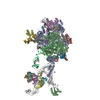
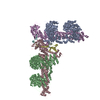

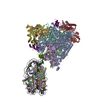
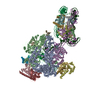

 PDBj
PDBj




































































